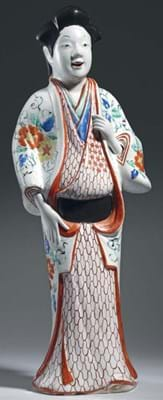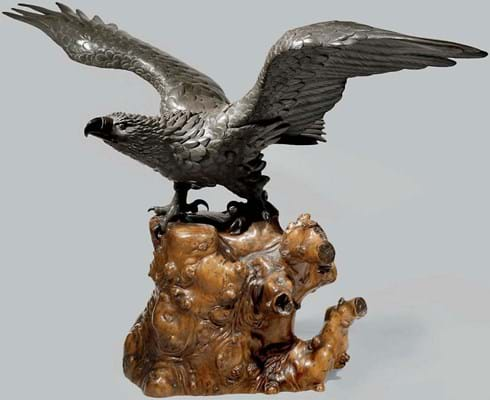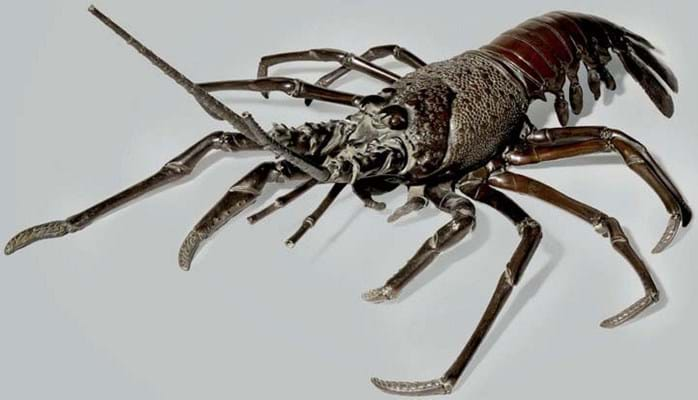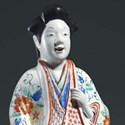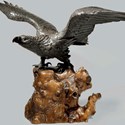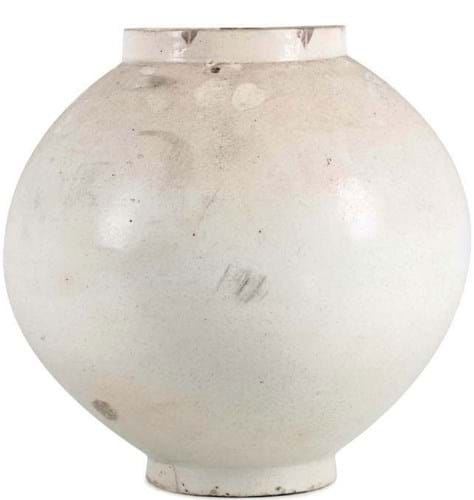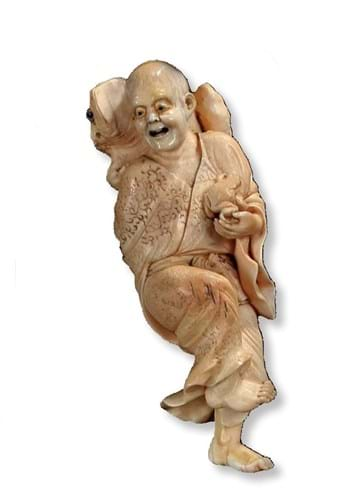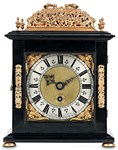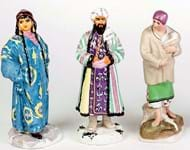Overshadowing all aspects of Asia – politically, militarily and economically – China’s dominance in the art world was again reflected in the spring sales in the major English auction houses.
Nevertheless, the continent does have more to offer, particularly to Western collectors of fine Japanese material where prices have reflected the flatlining of the Tokyo economy.
So, while the Chinese sales took £3.8m at Woolley & Wallis (25% buyer’s premium) at Salisbury on May 22-23, the focus of this report is the £228,000 total for a 180-lot Japanese and Korean sale offered on the afternoon of May 23.
A total of 128 lots got away, including a number of five-figure lots led by a Kakiemon bijin (literally ‘beautiful person’).
The smiling 15¼in (39cm) tall figure was dated c.1690, within the lifetime of Sakaido Kakiemon, the Arita potter who developed the overglazed ‘enamelled’ porcelain technique.
A very similar figure, offered as part of a tray lot in a sale in Wales in January, had leapt beyond a £20-30 estimate to sell for £11,500 (plus premium). Estimated at £15,000- 25,000, this latest example sold to the European trade at £27,000.
‘Picking up’
“It seems that the Japanese market is picking up, especially for early porcelain such as late 17th century Kakiemon and good-quality Satsuma and metalwork,” said W&W expert Alexandra Aquila.
A rare c.1680 Kakiemon water dropper modelled as a 5¾in (14.5cm) boy seated on a drum with a double gourd slung over his shoulder sold at £11,000 (estimate £2000-3000), also to the European trade
“The water dropper boy had a large crack to the back and the bijin had a chipped foot – but neither was restored and I believe the buyers preferred it this way,” said Aquila.
Early ceramics also included a near pair of late 17th century Arita blue and white octagonal vases.
Standing 2ft 4in (72cm) tall with domed covers and decorated with ho-ho birds among rocks, they were estimated at £4000-6000 and sold to a UK dealer at £11,500.
While some Japanese buyers were active, most of the better pieces went to British and European dealers.
Aquila noted a rise in interest from France. “There are many events in France this year celebrating the 150th anniversary of the Meiji Restoration and the Franco-Japanese relationship, and French dealers seem to be buying for this,” she said.
Best of the Meiji material was an 11½in (29cm) tall Satsuma spherical vase. Finely decorated with a dense continuous design of musicians, courtesans and guests at a tea house, the base was inscribed Kinkozan zo and Shozan/Masayama and bore another impressed mark for Kinkozan zo.
There are many events in France this year celebrating the 150th anniversary of the Meiji Restoration
With that guarantee of quality, the vase was estimated at £4000-6000, a level quickly left behind before the vase sold to the English trade at £19,000.
Another Meiji prize for the English trade was a massive okimono, a 3ft 4in (1.01m) wide bronze eagle on burrwood base. The eagle, with pupils picked out in gilt and details in shakudo, is similar to another shown at the 1893 Chicago World’s Columbian Exposition. Estimated at £3000-5000, the eagle took £17,000.
Metalwork okimonos got the day off to a fine start, with three articulated bronze models of creatures known as kusshin (elastic) jizai. First made in small numbers by 18th century armourers during the peaceful years in the Edo period, these okimonos with eyes picked out in gilt or shakudo became popular during the Meiji export boom.
At W&W a 17in (42.5cm) long iron snake went above expectations at £1900, a 10¼in (26cm) wide copper alloy crab took a quadruple-estimate £2600 and a 16½in (42cm) long bronze spiny lobster, unsigned but of high quality, sold to the English trade at £4000 (estimate £2000-3000).
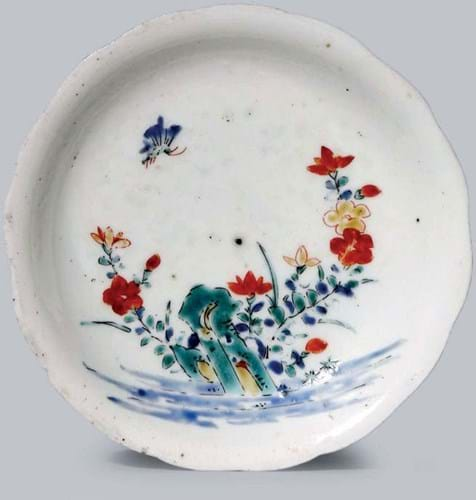
While Kakiemon porcelain from the 17th century made five-figure sums at the Woolley & Wallis sale, collectors willing to accept a few condition problems can start at a much lower level. This c.1670, 4¼in (11cm) diameter scalloped dish, decorated with a butterfly fluttering over flowers and rockwork, suffered some fritting and pitting and sold at a mid-estimate £250 (plus 25% premium) to a Japanese buyer.
The Korean presence in the sale was relatively small but included a 10½in (26.5cm) tall gilt bronze figure of Buddha catalogued as Koryo (918-1392) or Choson (1392-1897) dynasty.
Sitting in the dhyanasana meditative position on a lotus throne with robes picked out in gilt, it was estimated at £1000-2000 but eventually sold to a UK collector at £18,000.
“Bidders seem very keen to get their hands on anything Korean coming up at the moment, especially ceramics,” said Aquila.
Choson at Chiswick
The £1m May 24-25 Asia sales at Chiswick Auctions (25% buyer’s premium) were also dominated by Chinese material but among the best-performing lots was a white-glazed moon flask, the most recognised ceramic form of the Choson period. Standing 13in (33cm), it sparked huge interest at a modest estimate of £400-600.
Bidding took off in the room and online and the jar finally sold to an anonymous bid at £31,000.
Two lesser Choson pieces, a 12½in (31.5cm) tall, pear-shaped blue and white dragon vase and a 7in (17.5cm) diameter, conical-form celadon bowl went on their lower estimates of £300 and £100 respectively.
A first for Suffolk
Launched three years ago, the Suffolk auction house Bishop & Miller (19% buyer’s premium) ventured into the Asian market with its first Oriental Art sale on May 24.
“There’s always a sense of trepidation when we launch a new specialist sale but it exceeded our expectations,” said auctioneer Oliver Miller after 80% of the 410 lots at the Stowmarket rooms got away to a total of £70,000, with most of the better sellers coming from Japan. A factor also noted by Alexandra Aquila at W&W was that the controversial ivory issue has yet to make a real impact in the saleroom, at least among European buyers.
At Stowmarket, an Edo period (1603-1868), 4¾in (12cm) long ivory netsuke of a smiling Gama-Senmin (‘Toad Immortal’) standing on one foot with a huge toad on his shoulder and a small one in his hand went a shade over hopes to a UK collector at £3100.
An 18th century 2¼in (6cm) ivory netsuke of a dog chewing a sandal doubled the lower estimate in selling at £1400.
Another in-demand piece of Edo carving was a 15¾in (40cm) boxwood seated tiger which sold to a UK collector at £2100 against a £600-900 estimate.
Best of the Chinese material was small Qing handling jade. Dated to the 19th century, the 1¼in (3.5cm) high carving of a monkey with another on its back holding a gourd was pitched at £150-250 and sold to a Paris dealer at £2100.


